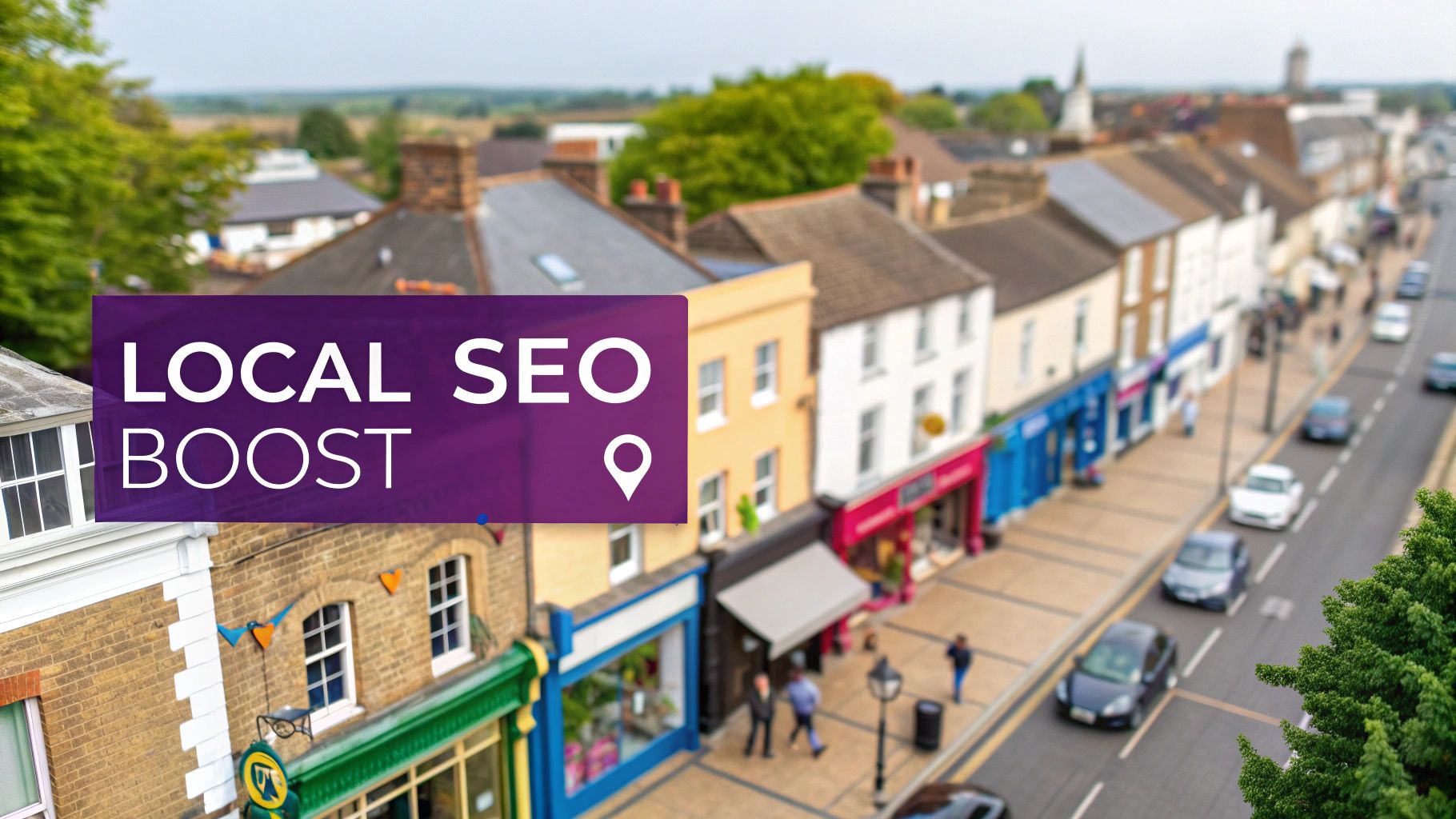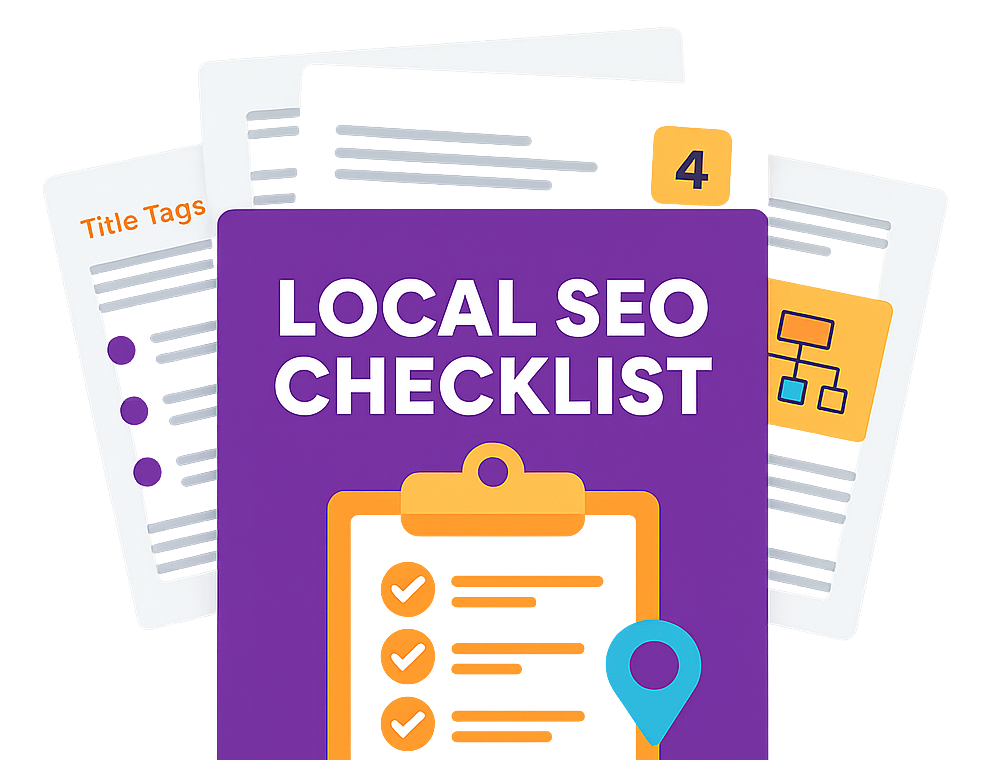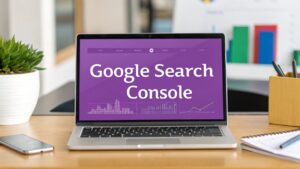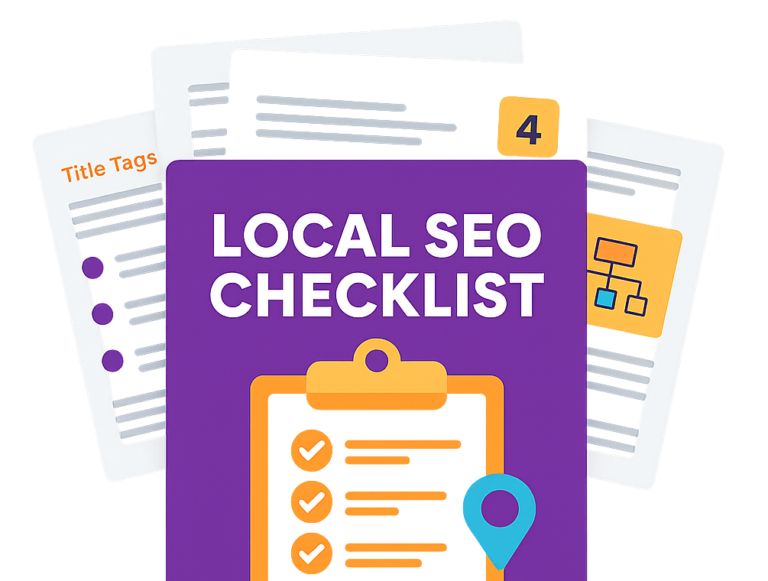Ever wondered how to get your business to show up for searches like "emergency plumber in Manchester"? The secret often lies in a smart, targeted strategy: service area page SEO. This is all about creating and fine-tuning specific pages on your website for each town, city, or even neighbourhood you cover. It's how you prove your relevance right where your customers are looking.
Why Service Pages Are Your Local SEO Secret Weapon

Let's be real—getting found by local customers is a tough game. The old days of ranking for broad terms like "London plumbers" are pretty much over. Today’s customers search with pinpoint accuracy, targeting individual boroughs, towns, and sometimes even specific postcodes.
This is where dedicated service area pages give you a serious edge. These aren't just boilerplate pages with a town name swapped out. They're your chance to create a powerful, hyper-relevant resource that speaks directly to the needs of a local audience.
Capturing Hyper-Local Search Intent
When someone searches for "emergency roof repair in Islington," they're not looking for a company based out in Heathrow. They want a local pro who knows their area inside and out. Service area pages let you meet this exact search intent head-on.
Properly optimised pages are a direct pipeline to Google's highly-prized Local Pack. They build instant trust by signalling that you have a genuine, boots-on-the-ground presence, even if you don’t have a physical office in every single location.
This approach is especially critical in the UK, where people lean heavily on location-based searches. In fact, 42% of clicks on local searches go straight to Google’s Local Pack, making visibility there absolutely essential. What’s more, UK searchers demand accuracy; a whopping 62% will avoid businesses that list incorrect details. To truly grasp their impact, it helps to see where they fit into a comprehensive guide to local SEO services for small businesses.
The Pillars of a Winning Strategy
A great service area page strategy doesn't just happen. It’s built on a few core pillars that work together to signal your local authority to both search engines and potential customers.
These pillars include:
- Unique, Localised Content: Go beyond generic service descriptions. Talk about local landmarks, share customer stories from the area, and show you know the place.
- On-Page SEO Best Practices: This means crafting unique title tags, meta descriptions, and headers for every single location page. No cutting corners.
- Technical Signals: Use tools like schema markup and clean URL structures to make it crystal clear for Google which areas you serve.
- Building Local Trust: Nothing works better than proof. Feature local testimonials, case studies, and photos from jobs you’ve actually completed in that area.
The real goal here is to prove you're not just a company that can work in an area, but one that is an active and established part of that local community. That perception is what turns a searcher into a customer.
By mastering these elements—which we’ll break down in the sections to come—you can build a powerful network of assets that boosts your local authority and drives qualified, ready-to-buy leads right to your door.
How to Build Your First High-Performing Service Area Page
Staring at a blank page can feel a bit overwhelming, but don't worry. Building a service area page that actually performs is really just about following a proven framework. Let's walk through how to construct a solid foundation that appeals to both potential customers in a specific town and Google's ranking algorithms.
The goal here is simple: blend compelling, localised content with sound technical SEO. Get that mix right, and you're well on your way.
Start with the Digital Shop Window: Title Tags and Metas
Your page's title tag and meta description are its digital shop window. They're often the very first impression a user gets in the search results, so they absolutely need to be compelling.
Forget generic titles. You want a clear, benefit-driven structure that immediately tells the searcher, "Yes, you're in the right place."
- A Solid Title Tag Formula: [Main Service] in [Location] | [Your Business Name]
- Real-World Example: Emergency Boiler Repair in Cambridge | Bare Digital Plumbing
- Crafting the Meta Description: Focus on a key benefit and pop in a call to action. Something like, "Need fast boiler repair in Cambridge? Our certified engineers offer 24/7 call-outs. Get a free, no-obligation quote today and we'll be there within the hour."
This approach instantly confirms you're relevant to what they're searching for, making them far more likely to click through to your site instead of a competitor's.
Weave in Authentic Local Flavour
To truly stand out, your page needs to prove you're part of the local fabric, not just some faceless national company targeting a keyword. This is where you inject personality and build real trust.
Try mentioning specific landmarks or neighbourhoods you frequently work in. A Cambridge-based electrician, for instance, could add a line like, "We've rewired dozens of Victorian terraces near Mill Road and installed commercial lighting for businesses in the Science Park." See how that detail adds a layer of authenticity that generic content just can't match?
Of course, this all starts with understanding what local customers are actually searching for. This infographic breaks down the foundational process of local keyword research.

As the image shows, successful service area pages begin with deep-dive keyword analysis, not just jumping straight into page creation.
Another powerful move is to feature testimonials from clients within that specific area. A quote from "Sarah in Chesterton" carries far more weight on your Cambridge page than a generic review ever could. It’s social proof that you deliver quality work for their neighbours. To get a handle on this, you can check out some of the best local SEO tools in 2023 to track performance and spot these opportunities.
A great service area page does more than just state you serve a location; it proves it with tangible, local evidence. This is the difference between simply ranking and actually winning the customer.
Nail the On-Page Essentials
Now, let's get into the nitty-gritty. Solid on-page SEO ensures search engines can easily understand, categorise, and rank your page for the right local searches. Here is a quick checklist of the core elements you need to get right.
Core On-Page Elements for Service Area Pages
| Element | Best Practice Example | Why It Matters |
|---|---|---|
| Clean URL | yoursite.co.uk/services/electrician-cambridge |
A logical URL tells Google (and users) exactly what the page is about before they even click. |
| H1 Tag | <h1>Expert Electrician in Cambridge</h1> |
This is your main heading. It should clearly state the primary service and location. |
| Localised Content | Mentioning landmarks, neighbourhoods, or local projects. | Builds trust and proves you're genuinely part of the community, not just keyword stuffing. |
| Local Testimonials | "Sarah from Chesterton says…" | Provides powerful social proof and reinforces your connection to the specific area. |
| Embedded Map | A Google Map showing your service area or office. | A strong visual signal to both users and Google, anchoring your page to the physical location. |
| NAP Information | Consistent Name, Address, Phone number. | Critical for local SEO. It must be consistent with your Google Business Profile and other citations. |
Getting these elements right is non-negotiable. It’s the combination of authentic local content and technical precision that truly drives results.
In fact, industry data shows that local and organic searches together account for approximately 69% of all digital traffic in the UK. That number alone highlights the immense value of getting your local SEO strategy spot on. A well-executed service area page is your ticket to capturing a piece of that traffic.
Creating Unique Content That Actually Ranks

This is where so many businesses get it wrong. The thought of creating genuinely unique content for dozens of different service area pages feels massive, so they fall back on repetitive, templated copy. Unsurprisingly, it fails to impress search engines or customers.
The trick isn't just to avoid duplicate content—it's to build pages that are genuinely valuable and feel local.
The best way to do this is by building a flexible content framework. Think of it as a master blueprint you can easily customise, making sure every page feels distinct without starting from scratch each time. This goes way beyond just swapping out a town name in a heading.
Building Your Content Framework
To avoid the copy-and-paste trap, your framework needs designated sections that demand unique, location-specific details. This forces you to think like a local and prove you actually belong in the community you're targeting.
Your framework could have dedicated spots for things like:
- A Local Project Spotlight: Briefly describe a job you completed in that specific area. A roofer in Liverpool, for example, could mention, "We recently finished a full slate roof replacement for a Victorian property just off Lark Lane."
- Area-Specific FAQs: Answer questions that only apply to that location. A London-based courier might address: "Do your delivery fees for Islington include the Congestion Charge?" This shows a real understanding of local details.
- Photos of Your Team On-Site: Nothing builds trust faster than seeing your team working in a familiar setting. A photo from a local job is far more powerful than a generic stock image.
This structured approach makes scaling your service area pages SEO much more manageable and, frankly, more effective. If you need more guidance on how these pages fit into the bigger picture, you can explore some effective local SEO strategies that tie it all together.
The Power of Local Social Proof
Beyond your own content, embedding local social proof is an absolute game-changer for building trust. It’s one thing for you to say you’re great; it’s another for a customer’s neighbour to say it.
You need to actively collect and showcase reviews from customers in each specific postcode. A testimonial from "David in Didsbury, Manchester" on your Didsbury page provides a powerful, hyper-local endorsement that just clicks with other residents.
This taps directly into consumer behaviour in the UK, where 42% of consumers regularly check online reviews when looking into local businesses. A staggering 37% expect at least a 4-star rating before even considering a service, making that positive local feedback non-negotiable.
The goal is to create a compelling narrative for each location. You're not just a service provider; you are the local expert who understands the area, has a proven track record there, and is trusted by the community.
By combining a smart, customisable content framework with authentic local social proof, your pages will transform from simple listings into valuable resources. Google will favour them, and so will your future customers. This is how you create content that truly ranks and converts.
Advanced Optimisation and Technical SEO
Once you’ve nailed the on-page fundamentals, it’s time to pull ahead of the competition with some of the more technical details. Think of these as the finishing touches that give your service area pages a serious edge, helping search engines understand precisely what you do and where you do it.
Getting these technical signals right can be the difference between blending into the background and standing out in local search results.
Get to Grips With Local Business Schema Markup
Schema markup is a bit like a translator for search engines. It’s a piece of code you add to your website that gives them explicit, structured information about your business. For service area pages SEO, the LocalBusiness schema is your most powerful tool.
This structured data lets you clearly spell out key details for search engines, including:
- The exact service you offer (like
PlumberorElectrician). - The specific areas you serve (
areaServed). - Your opening hours, phone number, and address.
By feeding this information directly to search engines in a language they understand, you remove all the guesswork. This can lead to your business getting featured in eye-catching rich results, like map packs and knowledge panels, which customers are far more likely to click on. You're essentially spoon-feeding Google the exact information it needs to rank you accurately.
Build a Logical Internal Linking Structure
Your service area pages shouldn't be digital islands; they need to be woven into the very fabric of your website. A smart internal linking strategy creates a logical map, spreading authority and helping both users and search crawlers navigate your site with ease.
One of the most effective tactics is to create a central "Areas We Serve" hub page. This main page can list all the individual towns or neighbourhoods you cover, with each one linking directly to its dedicated service area page.
This hub-and-spoke model signals to Google that all these locations are connected and part of a broader, authoritative service network. It transforms a collection of individual pages into a cohesive local ecosystem.
From each service area page, you should also link back to your main service pages (e.g., "Boiler Installations," "Emergency Call-Outs"). This reinforces the relationship between your services and the locations where you offer them, creating a powerful web of relevance across your entire site. To take this a step further, make sure you understand the critical local search ranking factors that directly impact how visible your pages are.
Optimise Your Images for Local Signals
Even your images can be powerful local SEO assets if you handle them correctly. Don’t just upload files with generic names like IMG_2451.jpg. Instead, give them descriptive, location-based file names before you upload them.
For example:
- Instead of:
team-photo.jpg - Use:
bare-digital-plumbers-in-cambridge.jpg
This simple step provides another contextual clue to search engines about the page's content and location. You also need to optimise your image alt text—the text that describes an image for screen readers and also for search engines if the image fails to load.
An effective alt text would be something like: "The Bare Digital team of expert plumbers working on a boiler installation in Cambridge." This reinforces both your service and your location, making sure you capture every possible opportunity to signal your local relevance.
Connecting Your Pages to Your Broader Local Strategy
Your service area pages are powerful, but they don't work in isolation. To really make a dent in local search, you have to weave them into your wider marketing strategy. Think of it as building a local ecosystem where every part supports the others, rather than just having a bunch of disconnected pages.
This whole process starts with your most important local SEO tool: your Google Business Profile (GBP).
Syncing with Your Google Business Profile
For most local customers, your GBP is their first impression of your business online. It's absolutely non-negotiable that the details on your GBP match what's on your service area pages perfectly. The name, address (if you have one), and phone number (NAP) need to be identical everywhere to build trust with Google.
Here's a crucial tip: when you list your service areas in your GBP settings, don't just link your profile back to your homepage. That’s a missed opportunity. Instead, link directly to the most relevant service area page. If someone in Manchester stumbles upon your GBP, the website link should take them straight to your Manchester page, not a generic one. This creates a much smoother and more relevant journey for them.
If you want to go deeper on this, our complete guide to Google Business Profile optimisation has all the details you’ll need.
Earning High-Value Local Backlinks
Backlinks are still a massive ranking factor, and for local businesses, it's all about relevance. Forget about chasing links from huge national websites; your time is much better spent earning authority from right inside the communities you serve.
These locally relevant links are pure gold. Here are a few practical ideas to get you started:
- Sponsor a local youth football team and ask for a link from their website.
- Get featured in a neighbourhood blog or local online paper for a recent project.
- Team up with a non-competing local business for a joint promotion and swap links.
When you do manage to get these local links, always make sure they point to the specific service area page, not just your homepage. A link from a Bristol community site pointing to your
/plumbers-bristolpage sends a powerful signal to Google that you're a genuine, authoritative player in that specific market.
To get the most out of your service area pages, you need to see them as a core part of your business development plan. They aren't just an SEO box to tick; they are one of the essential growth strategies for service-based businesses that drives real results. When you connect your on-page work with off-page local authority, you build a powerful online presence that your competitors will find incredibly difficult to challenge.
Common Service Area Page SEO Questions Answered
When you get into the weeds of service area page SEO, a few tricky questions always seem to pop up. Getting clear, straightforward answers is the key to fine-tuning your strategy and dodging the common mistakes that can tank your local rankings. Let's tackle some of the most frequent ones I hear.
One of the biggest hang-ups is content duplication. If you’re a plumber covering twenty different towns, how on earth do you create unique content for each page without it sounding like a broken record?
The secret is to think locally. Instead of just describing your service, describe your service in that specific location. Mention a recent job you completed there, reference local landmarks, or answer a question that’s unique to residents of that area. This way, each page provides distinct, genuine value.
Can I Use One Page for Multiple Locations?
It might feel efficient to just list all your service areas on a single page, but honestly, it's a massive missed opportunity. A single page just doesn't have the ranking power for specific, geo-targeted searches like "emergency plumber in Bristol."
By creating a dedicated page for each key location, you're building a highly relevant asset that can be perfectly optimised for that exact search query. This targeted approach is absolutely fundamental to a successful local SEO strategy. You can learn more about crafting a winning approach in our guide to small business local SEO.
How Many Service Area Pages Should I Create?
There’s no magic number here—quality will always beat quantity. Start with your highest-priority areas, the locations that bring in the most business or have the most untapped potential. Build out high-quality, unique pages for these first.
Once you see those performing well, you can start to expand. Slapping up fifty thin, low-quality pages will do you more harm than good. It’s far better to have ten excellent, well-optimised pages that genuinely help the user.
Don't mistake a long list of locations for a strong local presence. A handful of deeply localised, high-performing pages will always deliver better results than a hundred generic ones. Focus your efforts where they will have the most impact.
At the end of the day, the goal is to prove your relevance and authority in every single market you claim to serve.
Ready to turn local searches into paying customers? Bare Digital offers expert SEO services designed to get your business noticed. We create data-driven strategies that boost your rankings and deliver real results. Get your free, no-obligation SEO Health Check and a transparent Activity Plan today. Visit us at https://www.bare-digital.com to start your journey.








